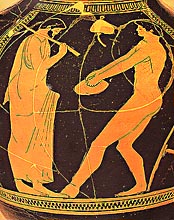
 |
If someone disputed his liability for liturgy, he could challenge someone he considered wealthier to take on the financial burden, or else request antidosis, that is the exchange of his property for his own.
The most important liturgies were the following:
The Trierarchia: the most expensive liturgy, concerned with providing money for the construction, maintenance and manning of a trireme for a year.
The Choregia: the cost of preparing of a chorus to participate in dramatic and lyrical contests. It is estimated that there were ninety-seven choregies annually, rising to 118 in the year of the Panathenaea.
The Gymnasiarchia: the cost of training and the nutrition of athletes participating in torch-races.
The Estiasi: the cost of a public meal, especially in periods of festivals, ceremonies and games.
The Architheoria: the expenses of the delegation of Athenian deputies to the great Panhellenic festivals, or to oracles.
The Arrephoria: the special expenses for the parents of arrephors (two girls of noble birth, chosen to carry the peplos and other holy objects of Athena Polias in procession) during the Festival of Panathenaea. |





